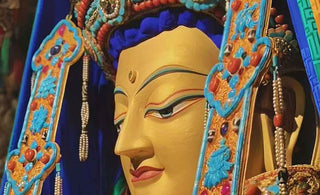
Tibetan antique statues, with their profound spiritual resonance and timeless aesthetic appeal, serve as wellsprings of inspiration for a new generation of contemporary artists. In the dynamic intersection of tradition and modernity, these artists embark on a journey to revive the past, infusing ancient wisdom with a fresh breath of creativity. The keyword "reviving" takes center stage as we delve into the ways in which artists draw from the well of Tibetan antiquity to create contemporary masterpieces that resonate with both the echoes of history and the pulse of the present.
Contemporary artists, enamored by the ethereal beauty and spiritual depth encapsulated in Tibetan antique statues, find themselves captivated by the challenge of reinterpreting tradition in a modern context. The revival of ancient techniques, such as the intricate metalwork and precise carving seen in historical statues, becomes a testament to the timelessness of craftsmanship. These artists navigate the delicate balance between preserving the authenticity of the past and infusing their creations with a distinct contemporary flair.
In the pursuit of reviving Tibetan antique statues, artists often embark on extensive research journeys, immersing themselves in the cultural and spiritual contexts that birthed these timeless artifacts. In the passionate pursuit of reviving Tibetan antique statues, contemporary artists embark on transformative research journeys, delving deep into the rich tapestry of cultural and spiritual contexts that birthed these timeless artifacts. One notable example is the artistic odyssey of Emma Chen, a visionary sculptor renowned for her dedication to merging ancient Tibetan traditions with a contemporary artistic ethos.
Emma Chen's exploration begins not in the studio but amidst the sacred landscapes of Tibet itself. Undertaking immersive journeys to monasteries, remote villages, and cultural centers, she immerses herself in the very environments that cultivated the spiritual and artistic essence of Tibetan statues. Chen's commitment to understanding the historical and cultural roots of these statues is reflected in her extensive documentation of rituals, conversations with local artisans, and meticulous study of ancient scriptures.
One of her transformative experiences unfolds in the serene courtyards of Jokhang Temple in Lhasa, where she witnesses monks engaging in rituals that have been performed for centuries. These rituals, once merely descriptions in historical texts, come alive before her eyes, offering a profound insight into the spiritual practices that inspired the creation of Tibetan statues. Chen notes the intricate details of gestures, the resonance of chants, and the ambient energy that infuses the sacred space.
Chen's research extends beyond the physical aspects of Tibetan statues to encompass the symbolic language woven into each piece. The lotus flower, the various mudras (hand gestures), and the symbolism of specific deities all become chapters in her visual storytelling. Her notebooks brim with sketches, annotations, and reflections as she endeavors to comprehend not only the craftsmanship but the spiritual stories embedded in the statues.
Back in her studio, armed with insights garnered from these immersive journeys, Chen engages in a dialogue with tradition. Her hands deftly mold clay, drawing inspiration from the ancient techniques she observed. Yet, her artistic voice asserts itself as she introduces contemporary elements, seamlessly weaving the past and present into the fabric of her sculptures. The statues, once stoic relics, now resonate with a vibrancy that captures the evolving spirit of Tibetan culture.
Chen's creations become more than sculptures; they are conduits of cultural transmission and artistic evolution. In exhibitions, she accompanies her statues with narratives that bridge historical contexts with contemporary concerns. Through her work, she strives not merely to replicate the past but to reinterpret it, inviting viewers to witness the living dialogue between tradition and innovation.
The example of Emma Chen illustrates that the pursuit of reviving Tibetan antique statues is not a passive homage but an active engagement with living traditions. It showcases how artists, through dedicated research and a genuine connection with the cultural and spiritual roots, can breathe new life into ancient art forms, ensuring their relevance for generations to come. In the hands of such visionaries, the past becomes a wellspring of inspiration, and Tibetan antique statues find resonance in the ever-evolving landscape of artistic expression.
The contemporary reinterpretation of Tibetan antique statues extends beyond the choice of materials and techniques. Artists infuse their creations with narratives that resonate with contemporary themes, inviting viewers to engage with the statues on a deeper, more relatable level. Themes of environmental consciousness, social justice, and personal introspection find expression through the skillful hands of artists who draw inspiration from the profound stories embedded in the ancient statues.
The revivalist movement goes beyond individual artistic endeavors, manifesting in collaborative projects and exhibitions that celebrate the synthesis of tradition and innovation. Museums and galleries around the world host showcases that bring together the richness of Tibetan antiquity and the vibrant energy of contemporary expression. These exhibitions become spaces for dialogue, where the past and present engage in a visual conversation that transcends temporal boundaries.
Conclusion
In conclusion, the revival of Tibetan antique statues by contemporary artists is a testament to the enduring allure of cultural heritage. As they navigate the intricate tapestry of tradition, these artists infuse new narratives, perspectives, and energies into the ancient art form. The keyword "reviving" becomes a clarion call, inviting artists to delve into the past, extract its essence, and breathe it anew into the canvas of the present. The resulting creations not only pay homage to the profound legacy of Tibetan antiquity but also contribute to the ever-evolving narrative of human expression."

























